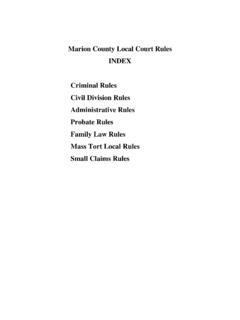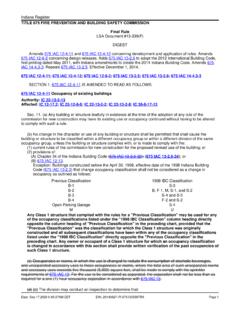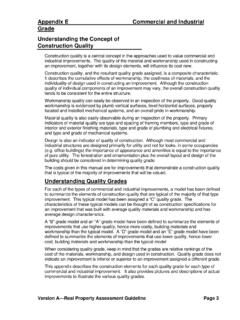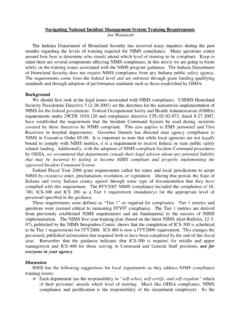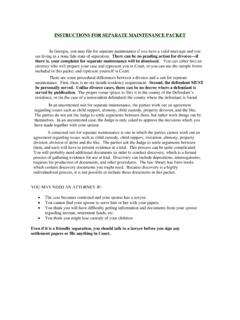Transcription of Indiana Supreme Court Self-Service Legal Center …
1 Indiana Supreme Court Self-Service Legal Center Page 1 Revised by State Court Administration 09/2014 Form Instructions for Divorce without Children and with Agreement on All Issues READ BEFORE YOU USE THIS PACKET When you sign a Court document, you may be helping or hurting your case. Before you sign any Court document or get involved with a Court case, it is important that you get advice from a lawyer to make sure you are doing the right thing. Going to Court without a lawyer is risky, and if you choose to be unrepresented, you must be prepared. This form packet has been created to help you, but certain courts have their own procedures and may not accept every form. In fact, courts in some counties have their own local form packets and may prefer that you use them. Check with your county clerk s office to find out: You may go to Court without representation, but you will have to abide by the appropriate Court rules, including Indiana Rules of Evidence, Indiana Rules of Trial Procedure, and any local rules.
2 Learn more about going to Court without a lawyer in an informative video at For additional information, you may refer to the Indiana Self-Service Legal Center that can be found at For Legal advice about your case, you should get in touch with a lawyer. Table of Contents Step 1: Who should use this packet .. 2 Step 2: Prepare your forms .. 2 Step 3: Printing your completed forms & understanding 3 Step 4: File your initial forms .. 4 Step 5: File your final forms .. 4 Step 6: The Decree of Dissolution .. 4 Form Instructions .. 5 Appearance by Unrepresented Person in Civil Case (Form # ) .. 5 Verified Petition for Dissolution of Marriage (Form #PS-31152-1) .. 7 Summons (Form # ) .. 9 Decree of Dissolution of Marriage (Form #PS-31152-9) .. 9 Indiana Supreme Court Self-Service Legal Center Page 2 Revised by State Court Administration 09/2014 Step 1: Who should use this packet You should use these instructions and the forms listed if you want to divorce your spouse AND: 1.
3 You or your spouse have lived in Indiana for at least the past six months and one of you has lived in your current county for at least the past three months; 2. You are not currently pregnant with your spouse s child, or your spouse is not pregnant with your child; 3. Neither you nor your spouse is currently in the military; and 4. You and your spouse do have an agreement on how property should be divided. If either you or your spouse is in the military, or if you or your spouse is pregnant, DO NOT use these instructions and the forms listed. There are special issues in your case that these forms do not address, and you need to seek Legal advice from a lawyer. If you are seeking a protection order, you may obtain a petition form from the Clerk of the Court or seek help from a victim advocate. A petition for a protection order must be filed as a separate case from this dissolution matter. For more information, see Step 2: Prepare your forms Specific instructions for each form begin on page 5.
4 You should fill out the following forms: Form Title Form Number Details When to File Appearance By Unrepresented Person in Civil Case This form notifies the Court that you intend to participate in a civil case. See Step 4 Verified Petition for Dissolution of Marriage PS-31152-14 This form asks the Court to grant you a divorce and make temporary arrangements until the case is over. See Step 4 Summons This form notifies your spouse that you have filed for divorce and that your spouse must also file an appearance in the case in order to participate in it. See Step 4 Verified Waiver of Final Hearing PS-31152-2 This form informs the Court that because you and your spouse agree to the terms of the divorce, you waive your right to a final hearing. See Step 5 Decree of Dissolution of Marriage PS-31152-9 This form is the final order of the Court ending the marriage and outlining the final arrangements for things like child custody, visitation, and housing.
5 See Step 6 Indiana Supreme Court Self-Service Legal Center Page 3 Revised by State Court Administration 09/2014 You can either print the blank forms and fill them out by hand, or fill them out on the computer and then print them out, but you need to learn more about what color paper to use and how many copies you ll need: See Step 3 for important information about using light green paper to print the Appearance Confidential Form. Review your local Court rules to find out how many copies you will need, and any additional forms or procedures required in your county. Read your county s local rules here: In addition to the forms above, you will need to prepare child support forms. See Step 5 for more information. If you cannot afford it, you may ask the Court to waive the divorce filing fee. To do so, complete the Motion for Fee Waiver in a Divorce form packet at Step 3: Printing your completed forms & understanding confidentiality About Confidentiality By law Court records are available to the public, and upon request anyone can look in almost any Court file.
6 The law also provides that certain information must remain confidential even if it is part of a Court record. Such confidential information must be filed on green paper so that everyone can easily identify it and not release it to the public. It is important that you know what information is confidential and that you submit it to the Court on green paper. Confidential information that should be filed on green paper includes: Social Security numbers, Bank account numbers, Tax records, PIN numbers, Medical records, Child abuse records For more information on this you may review Administrative Rule 9(G) at What to File on Green Paper in this Packet. Because you do not have children, you do not need to file the Confidential Form-Not for Public Use which must be filed on green paper. No other forms in this packet ask for confidential information. Indiana Supreme Court Self-Service Legal Center Page 4 Revised by State Court Administration 09/2014 Step 4: File your initial forms Take the originals and copies of the following forms to the Clerk of the Court in the county where you (or your spouse) have lived for at least the last three months: Appearance By Unrepresented Person in Civil Case Verified Petition for Dissolution of Marriage Summons Locate your Clerk s Office here: The Clerk will provide the case number and process the forms.
7 The Clerk will stamp the forms with a filing date and give you back a copy. A copy of the file-stamped forms must be sent to your spouse s attorney, or to your spouse if he or she does not have an attorney. This is called service or being served. Service can be accomplished by mail, in person (for example, by a Sheriff or Sheriff s representative), or even by fax or email. Methods of service can vary by county, so ask your Clerk s Office about your options. Indiana law (IC 31-15-2-10) requires that you must wait at least 60 days to finish your divorce after you have filed these forms. Step 5: File your final forms After at least 60 days have passed since the filing of the Verified Petition for Dissolution of Marriage, take to the Clerk of the Court the originals and copies of: Verified Waiver of Final Hearing Decree of Dissolution The Clerk will keep the decree for the judge to sign. When you file your Decree of Dissolution, you must provide the Court with three copies and two pre-addressed stamped envelopes so the Clerk can mail one final copy to you and one to your spouse or their attorney.
8 Step 6: The Decree of Dissolution Because you and your spouse have agreed to waive the final hearing, the judge will review the final documents and will sign your Decree of Dissolution and mail a copy to both you and your spouse. You are divorced when the judge signs the Decree of Dissolution. You should not get re-married until you have a copy of the Decree of Dissolution signed by the Judge. Indiana Supreme Court Self-Service Legal Center Page 5 Revised by State Court Administration 09/2014 Form Instructions The instructions below correspond to the line numbers on the forms. Please make sure you fill in all the lines listed. Instructions for filling out the Appearance by Unrepresented Person in Civil Case (Form # ) Line # Instructions 1 Enter the name of the county where you are filing the divorce. After the form is printed, circle the Court (Superior or Circuit) in which it is being filed. 2 In the blank after the word Room, enter the Court number.
9 3 Enter the name of the county where you are filing the divorce. Leave the case number blank because the clerk will assign a number. 4 Enter the word Marriage and leave the space next to it blank. 5 Enter your full name. 8 Enter the name of your spouse. 12 Enter your full name. 13 Check this box if you are the person starting the case. 14 Check this box if you are the person responding to this case. 15 Check this box if you are the person intervening in this case (you are a third party to this case). 22-24 Enter your mailing address. 25 Enter your email address. Indiana Supreme Court Self-Service Legal Center Page 6 Revised by State Court Administration 09/2014 Line # Instructions 26 Check the box if you will accept electronic service of documents in your case at the email address you provided on line 25. Counties with electronic service may not send any documents by mail if you check this box, so if you are willing to accept electronic service, be sure to regularly check your email inbox for new messages about your case.
10 You can ask the clerk about their electronic service practices. 27 Enter the phone number at which you would like to be contacted about your case. 28 If you have a fax, enter your fax number. 29 Check the box if you are willing to accept service of documents in your case at the fax number you provided. 32 Check the box if you prefer not to provide a mailing address where you are staying, but instead would like to receive service of documents in your case through the confidential address provided by the Attorney General s Office. This is typically used in cases involving domestic violence to keep your current address confidential. 33 Leave blank. The clerk will provide this information. 41-42 Check the No box 44-45 If you have any other pending cases related to your divorce case, check the Yes box). Otherwise, check the box to the left of No. 47-52 If you checked yes on Line 44, enter the case caption(s) and case number(s).



